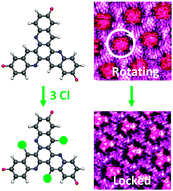Locking the free-rotation of a prochiral star-shaped guest molecule inside a two-dimensional nanoporous network by introduction of chlorine atoms†‡
Abstract
Two star-shaped

- This article is part of the themed collection: Molecule-based surface chemistry

 Please wait while we load your content...
Please wait while we load your content...